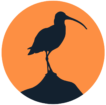People who love waders, like the birds themselves, flock together in the autumn at the annual conference of the International Wader Study Group (IWSG). The range of attendees mirrored the diversity of wading birds scattered across the mudflats surrounding the island of Sylt off the northern coast of Germany, where the meeting was held. I can’t describe the conference better than the blurb on the website:
The IWSG Annual Conference is one of the highlights of the year for anyone interested in waders, shorebird science and conservation. In a different European country each year, the conference usually spans a weekend in September or October. We pride ourselves in running friendly conferences attended by ringers, students, wader enthusiasts and conservationist biologists. Each conference includes two days of lectures, poster sessions, local excursions, plus one or more workshops on special themes.

People couldn’t have been more friendly, and the bonhomie was palpable from the minute you register. The accommodation was in Rantum in the south of the island, an austere collection of low buildings (originally built by the Nazis) which usually hosts student groups. It worked well with bedrooms, lecture rooms and a restaurant all on site.
The coastal feel is ever-present, and there is little to break the salt-laden wind and rain coming straight off the North Sea. For a conference on wading birds, the setting was pretty much perfect.
Parallel sessions covered a wide variety of conservation and pure science for a range of wader species, you can download the programme through the IWSG website. The snapshot below gives a sense of the variety of talks from Saturday’s programme. Curlew got a lot of attention.

The Curlew talks covered topics such as site fidelity in wintering areas, the increasingly popular use of headstarting and the status of Curlews in different countries (not uplifting). The use of nest cameras and their effect on nest survival gave the reassuring indication that there is little evidence of negative effects.
It is clear so much passion, brain power and indeed cash is being poured into Curlew conservation, yet numbers continue to fall in most areas and fledging success remains stubbornly low. That is telling us something very important. Curlews live across working landscapes – they nest on farmland and rough grasslands, places we use to grow food for ourselves and our livestock and where sheep and cattle are grazed. The agricultural system is designed around maximum productivity, not wild birds. Silage cutting, trampling, lack of insects, disturbance, high levels of predation and habitat loss see to it that few chicks fledge. The problems are deep and systemic across Europe, and only real changes in the way we use land will save them across much of their range.
This is not to say all the effort is a waste of time, far from it. We are learning all the time about what the birds need to survive and there are success stories to celebrate. The more we know the more there is to tell people and the greater the engagement in their survival. And the problems faced by Curlew are those challenging the success of other waders, too. We keep going and we keep trying. Doing nothing is not an option. The people doing the science and the fieldwork are to be lauded and congratulated, it can’t be easy.
My talk, right at the end of the two days, was on ecological grief. There is a growing problem of burnout and emotional attrition affecting many people feel working on declining species. Year after year of loss is hard to take; it hurts, and it has a price. People work on waders because they love them, and seeing their numbers fall is personally as well as professionally difficult to stomach. We need to talk more about it, and I have written an article on the talk which is in November’s issue of British Wildlife.
Before catching the bus to the train station on the last day I walked for an hour along the sea wall. It was calm and unseasonably warm, a gentle breeze carried the music of thousands of calling water birds. Sun glinted off the grey sea and mud and the horizons were vast. So much richness above and below the surface, so many beautiful birds in an evocative setting. It was a fitting place to ponder on the meeting and to pray we will do the right thing for this magnificent planet.
I encourage anyone who has an interest in wader science and conservation to go to an IWSG meeting. Everyone is welcome, from professor to amateur bird watcher, and it is the range of attendees that give this conference its special, welcoming, warm feel. I’ll be going next year (in France) and maybe see you there.
Main image: Aerial view of Sylt. (Photo by Ralf Roletschek via Wikimedia, by CC BY-SA 2.0 DEED)

